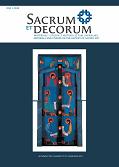Dziewiętnastowieczne malarstwo religijne jako przedmiot badań historii sztuki. Problemy i postulaty badawcze
19th century religious painting as a research object in art history. Research problems and postulates
Author(s): Joanna Lubos-KoziełSubject(s): Cultural history
Published by: Wydawnictwo Uniwersytetu Rzeszowskiego
Keywords: religious painting; sacred painting; 19th century
Summary/Abstract: Religious art of the 19th century did not arouse the interest of art historians until relatively late. This is why there are still numerous gaps in the research on the subject. In addition, studies of 19th-century religious art are not always accompanied by adequate methodological reflection or an understanding of the specific nature of the artistic current in question. The article draws attention to the following issues and problems, which should be kept in mind in the study of art in general and of 19th-century religious painting in particular: In the 19th century, religious art emerged as a separate current with a well-defined ideological program; it was also distinguished by the distinct style of works destined for the church. Keeping this separate status in mind, future research should take account of liturgical regulations, devotional practice, and the aesthetic and ideological agenda of the Church. At the same time, however, analyses of religious art should also deal with the broader external context shaped by the dominant secular currents of the period. An important problem for the study of religious art in the 19th century is posed by the evaluation of individual works and phenomena in question. We must oppose a generalized negative view of the period as a whole. On the other hand, it is equally unwarranted to judge it en bloc as being of high artistic value; alongside remarkable masterpieces, after all, the period also spawned a slew of works which were secondary and imitative, not to mention the abundance of mass-produced artistic items, such as chromolitographic prints, devotional drawings, etc. Importantly, all these areas are closely interrelated; in consequence, religious art in the 19th century can no longer be neatly divided into the high sphere of art and the low sphere of mass production. In this context, future research on 19th-century religious art should be called on to adopt a consistent descriptive and explanatory approach. Reconstructing the role of religious art in the broader culture of the 19th century can contribute to our understanding and acceptance of the aesthetic pluralism which marked the entire period.
Journal: Sacrum et Decorum. Materiały i studia z historii sztuki sakralnej
- Issue Year: 2009
- Issue No: 2
- Page Range: 8-15
- Page Count: 8
- Language: Polish

